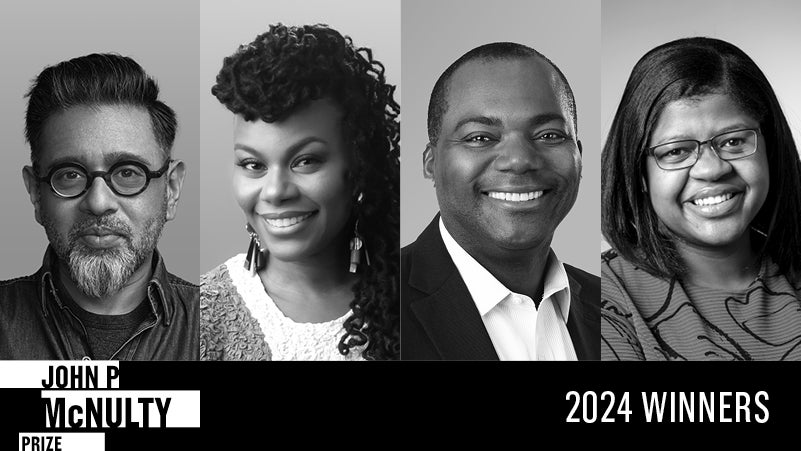The Aspen Institute was birthed in 1949 at a similar moment of existential threat and uncertainty that many are feeling today. Like then, we believe that the world needs better leaders who can help serve and protect human dignity. We need people in positions of trust and power to lead with values to make better decisions that do more good and commit fewer harms.
As co-founder and head of the Resnick Aspen Action Forum, I have spent the last decade deep in this work. Working year-round with the most dedicated and innovative team to experiment, learn, and practice how to create convening experiences that are both personally and socially transformative.
Year over year, we’ve seen the need to reimagine how we try to accomplish really big things. The challenges and opportunities that we face today are too great for any one program or organization, and even generations to tackle alone. As the Action Forum and leadership development work at the Aspen Institute evolve, I share this look under the hood with anyone interested in fostering leadership, exploring the relationship between leadership and community, and the art and science of bringing people together for humanistic learning and human-centered impact. I invite those who are interested to come together to share your learnings and practices so that we might support one another and those we serve to become better leaders.
“The Aspen Institute starts from an act of faith in the humanistic tradition: one must be reflective in order to insure that all human activity—political, scientific, economic, intellectual or artistic— will serve the needs of human beings and enrich and deepen their lives… With Erasmus, we hold that “nothing human is alien” to the inquiring purposes of the Aspen Institute.” – Statement outlining the philosophical basis of the Aspen Institute for Humanistic Studies was written by the Institute’s then-President, J.E. Slater, in 1972
Leadership starts from within each of us. Personally, as I lead this team and program, I often ask myself what do I personally need to do to be more self-aware and self-correcting? Am I aware of my biases? How do I hold, show up in, share, and offer space to others? What are the values, competencies, and actions that I need to focus on for my own personal growth and transformation before I ask Action Forum participants or team members to do so. I’ve learned that as I show up as the co-founder and steward of this program, it is an act of care and accompaniment with each person who participates and each colleague who contributes to this mission.
Questions for Reflection:
- Read this post about four practices to become a more human-centered leader. How might you model vulnerability and self-awareness? How can you create brave spaces to bring your team together – not for agreement, but for alignment?
- What do you want people to know and to feel through your leadership and the program you’re developing?
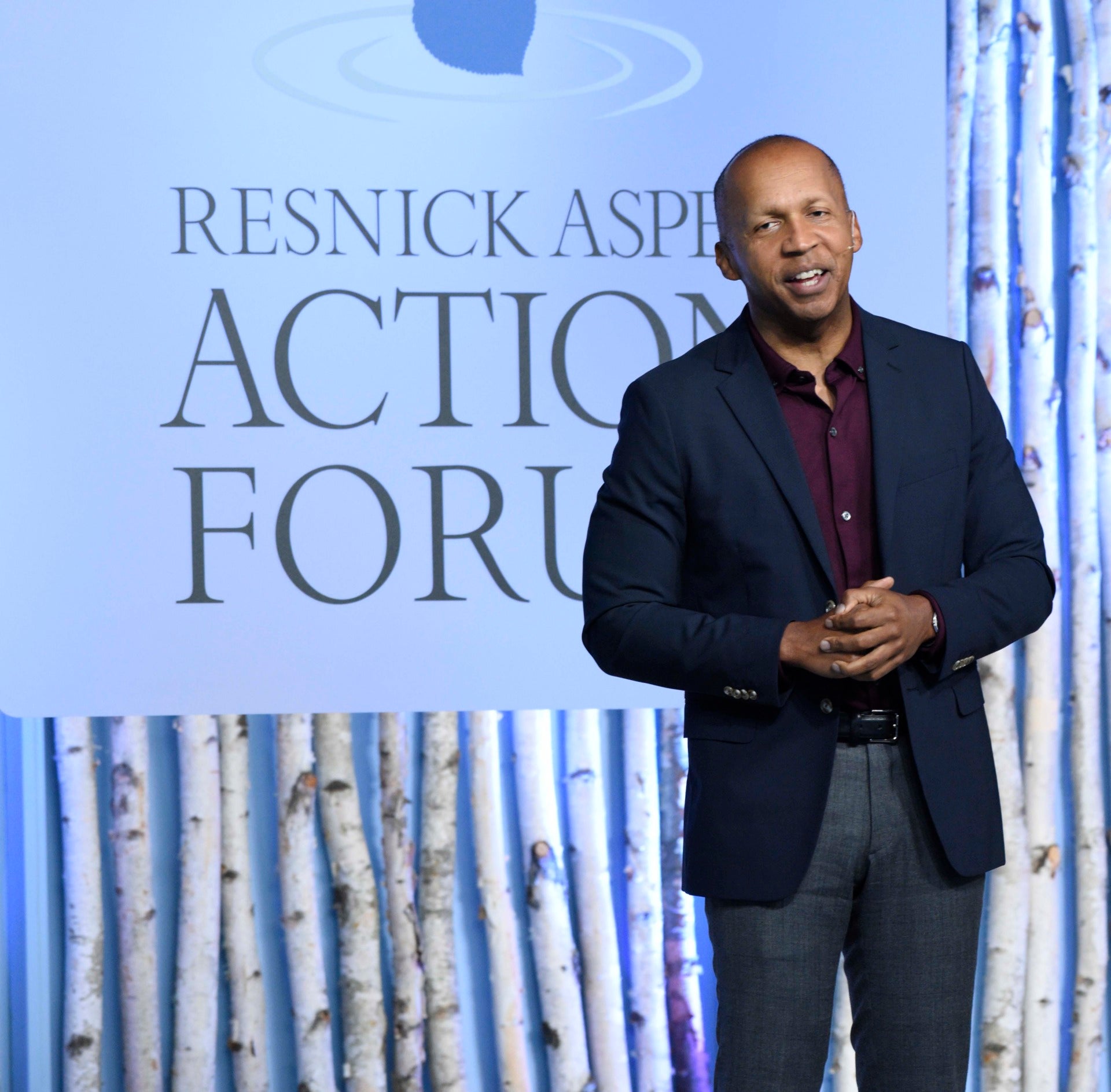
Brian Stevenson at the 2016 Action Forum delivering a keynote on the power of proximity.
In 2016, Bryan Stevenson challenged Action Forum participants to “get proximate”. A new practice we started this year is the formation of an advisory group made up of Fellows, fellowship programs, and other Institute staff to share perspectives, experiences, learnings, and be in relationship and dialogue about how to address and frame themes and topics to be globally inclusive. At a time when mental health and community well-being are so critical, the advisory group aided us in program development, the use of space, and for many risk scenarios which include adapting policies to protect against COVID-19.
Our team has also practiced “getting proximate” through more equitable access to the program – something key to bringing our global community from around the world together. This ranges from a large subsidy to bring the cost of participation to $1,850 USD while also offering financial support to fully waive the registration fee and cover roundtrip economy airfare and/or lodging. We’ve also experimented with event registration models based on pay-what-you-can, financial distributions to Fellowship Programs based on equity models to support collaboration post-event, and more.
In addition, and like many teams recently, we invested significantly in platforms for virtual programming, including serendipity spaces like Remo, small cohort seminars on Circl.es, as well as livestreamed keynotes and asynchronous pre-recorded learning labs.
Questions for Reflection:
- Who are the stakeholders in your organization, community or ecosystem that should “be at the table”? Who currently doesn’t have a seat?
- What might it look like for a group to come together that is representative of these stakeholders and offer a sense of belonging? What does it look like to support each member of this group to come together and participate in this effort?
- How might you design for accessibility and affordability in a way that is equitable and transparent?
- What context is important for your advisory group to be aware of? What are goals and outcomes, opportunities and challenges, assets and gaps, that might make this group more situationally aware as they offer direction and feedback?
The Aspen Institute explores how leadership shows up for people in and across contexts ranging from business and boardrooms, to leadership with families and communities, and across industries, sectors, systems, and much more. Within the Action Forum program, we set out to understand this through extensive outreach, listening, and co-designing in the “discovery” phase of the design process.
Our team crowd-sources using surveys, Zoom calls, emails, meet-ups, and more with the aim to create as many opportunities as possible to reach a broad and intentionally diverse cross section of the community we are designing for. We ask questions like: “What’s keeping you up at night?” “Where are you experiencing joy?” “What are you learning about yourself or others right now?”
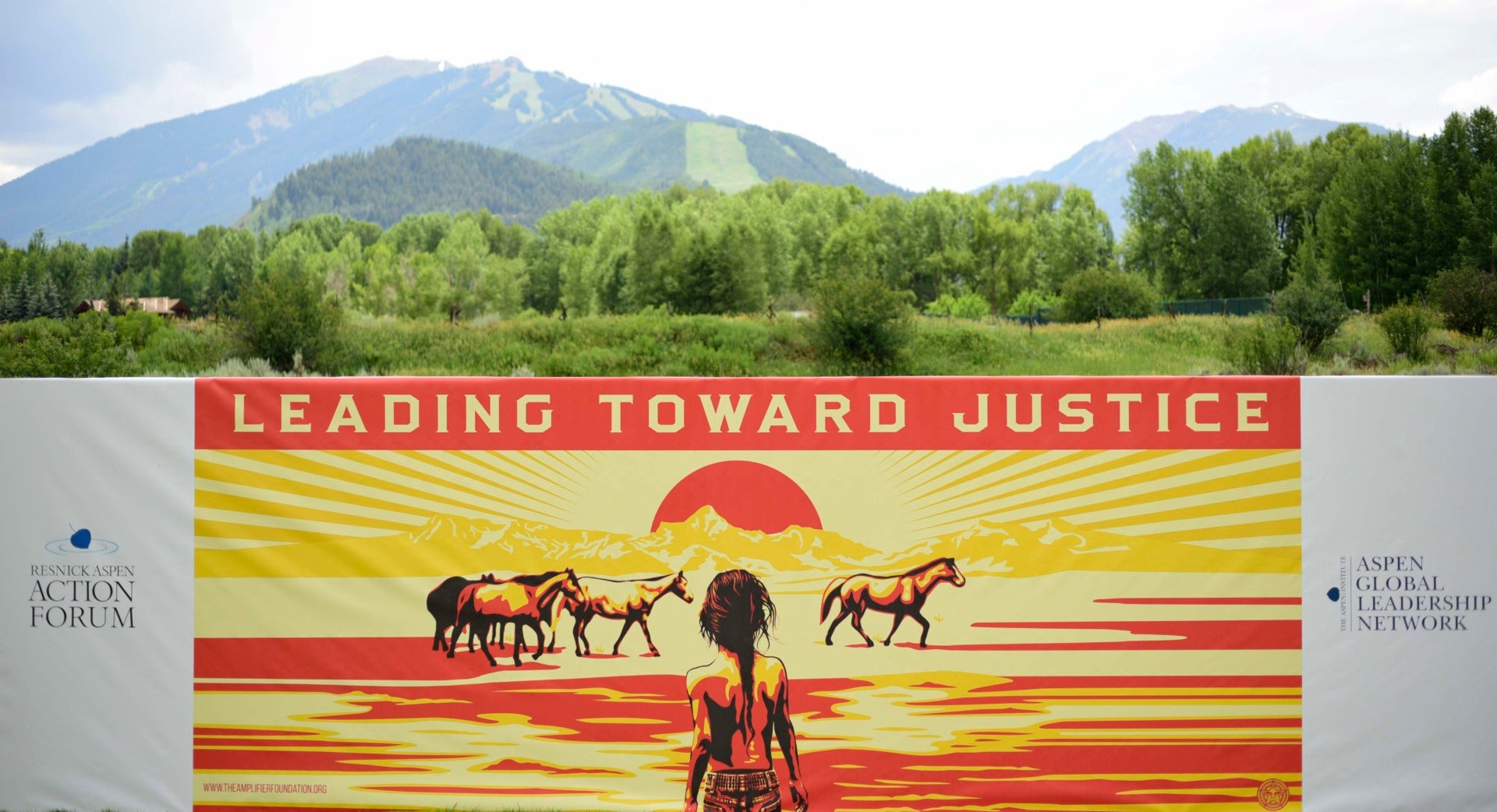
2016 Theme: Leading Toward Justice
Through a lot of writing and re-writing, framing and re-framing, and checking of biases and inclusivity, the first programmatic sprint is the journey of discovering, defining, developing, and delivering our annual theme. We aim to develop themes that reflect back and support the direction people want to be going with themselves and others. Over the past 10 years this process has led to themes ranging from “Disruptive Leadership” and “Collaborative Leadership: What does it take in a polarized world?”, to “Borders: Within & Around Us” and this year “Emergence: Into the future of our making.” As we develop this program, we try to make space and offer our platform to amplify the work of others.
Our team’s “duty of care” starts with the development of this theme. Any person who holds space for others appreciates the responsibility to not open wounds, close minds, or traumatize. Be mindful, considerate, and offer resources for the contexts you’re asking people to be in.
Questions for Reflection:
- What are the contexts people are experiencing? What approaches and models do you use to support someone’s becoming more self-aware?
- What are the intentions you’ve identified for holding space? How do you practice “duty of care”?
In 2017, I co-founded and launched a program with journalist David Brooks called “Weave: The Social Fabric Project” with the aim of building greater trust in our communities. In the initial listening tour, we heard from members of the Cincinnati-based StriveTogether organization that their work was built around the idea that their community is “program rich but systems poor.” As an entrepreneurial person who loves to build and lead teams, this insight has become a lens I frequently hold up to myself now. Do we need something new? Or, do we need to be better connected with one another? How might each of us build more relationships and connective tissue to bring together our shared wisdom, assets, and resources. How might we better connect the dots?
Today, the Aspen Institute represents more than 60 programs based out of the Washington, DC, headquarters. As just one of these programs, and with the AGLN making up about quarter of the other programs, a key design intention for this year’s Action Forum has been to offer more opportunities to foster new relationships and support curiosity between AGLN Fellows and the work of our colleagues across the Institute. To help enable this, our team has held 1:1 interviews with many of the Institute’s policy programs to map assets and explore existing impact opportunities like:
- Ascend’s four employer principles for family prosperity;
- AspenDigital’s mis and disinformation work;
- The Steven’s Initiative to connect youth virtually with targeted expansion in Mexico, Colombia, Argentina, Europe and Asia;
- The Braddock Scholars Program to scale impact initiatives;
- And the Financial Security Program’s 101 solutions to inclusive wealth building.
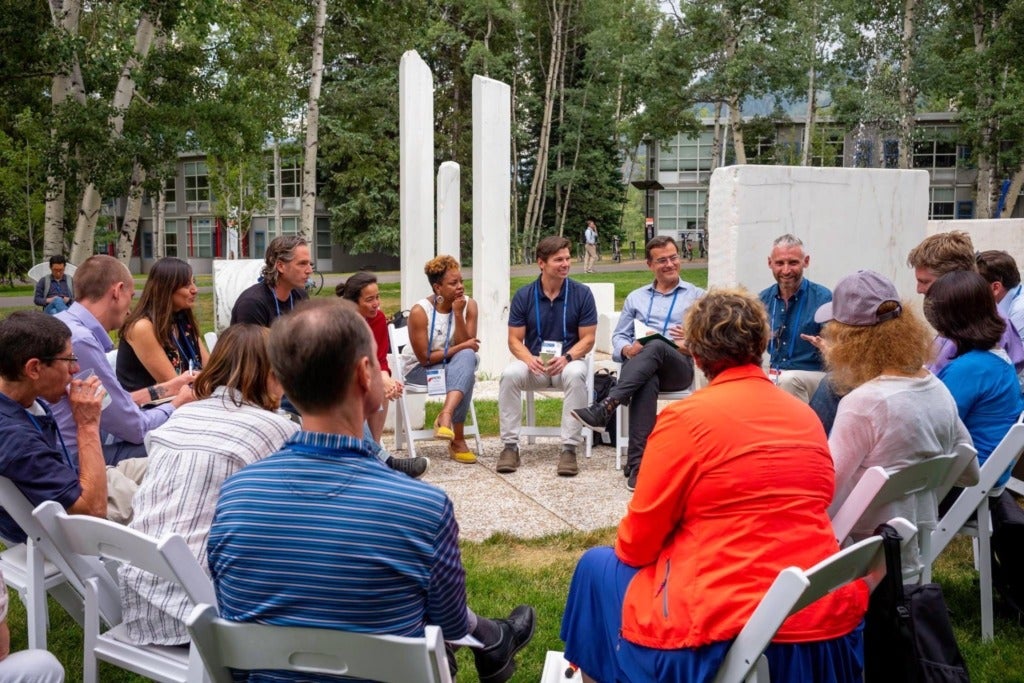
Breakout sessions at the Action Forum are key to fostering new relationships around specific issues.
Over the four-day program, 19 colleagues from programs across the Institute will be featured on-stage, participate in a program fair, and lead in the new Leadership Labs for skills building and Impact Breakouts for relationship-building and emerging collaboration opportunities. We hope and will evaluate how these efforts might connect more dots through more regional convenings.
Questions for Reflection:
- What might it look like to map the assets around your organization and/or your field? How might you offer space, time and resources to “connect the dots” and start building understanding and trust?
- If organizations offered opt-in opportunities for people to come together across our “network of networks”, what might be required to do this and with whom?
The original name of this organization was The Aspen Institute for Humanistic Studies. And the Institute’s method of text-based, socratic dialogue was developed to support people to become more self-aware and self-correcting. Our theory of change believes that meaningful societal transformation begins with the inner work of self-transformation and clarity of values to guide decision-making. Decisions are often more moral, not technical. And like the AGLN Fellowship programs, the Action Forum approaches personal transformation through text-based seminar dialogues.
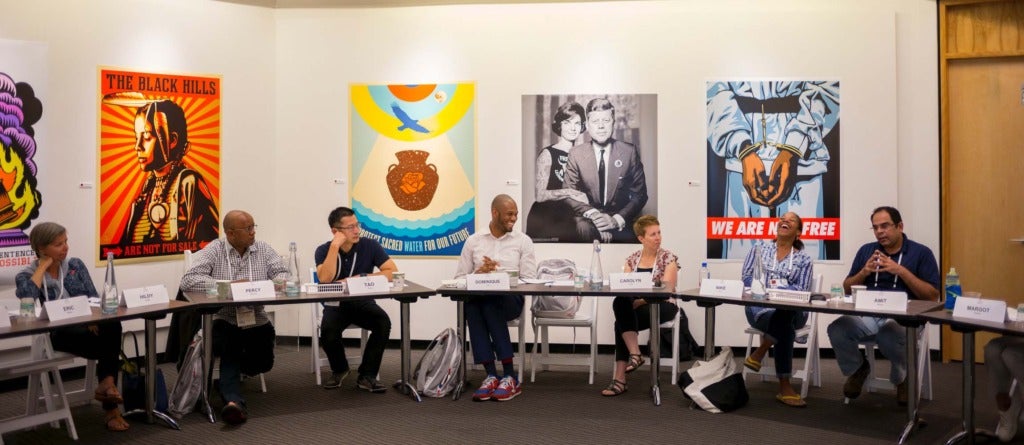
The Action Forum approaches personal transformation through text-based seminar dialogues.
For about five years, the Action Forum has developed seminar cohorts that stay together throughout the duration of the event. These cohort experiences have allowed for deeper understanding of others and oneself and have been measured in the 2020 AGLN Impact Report as helping people to become more self-aware (95% of respondents), more intentional or mindful in the way they live (96% of respondents), and more empathetic and understanding of different viewpoints and perspectives (92% of respondents).
Questions for Reflection:
- What spaces, exercises, and practices are you using to help people become more self-aware? What might it look like to offer opportunities to support a person’s personal transformation through lifelong accompaniment?
- Why do you believe people seek out your work? What is the work you feel you are most competent in and willing to share? What do you hope to learn with, access, or offer to others?
The Action Forum team has experimented with multiple approaches to support people as they strive to have a more positive impact in their communities and organizations. The 2020 AGLN Impact Report indicates that 98% of respondents – made up of members of the Fellowship community – increased their desire and/or confidence to have a positive impact. This shows up with people indicating that they are clearer about the values by which they lead and make decisions (91% of respondents) while people also took on risks and/or new challenges that they would not have pursued had it not been for the Fellowship experiences (87% of respondents). This data points back to the entrepreneurial profile of AGLN Fellows and taking action at the individual level which is terrific. And, our team was also curious to evaluate how Fellows support one another to have impact. We found that:
- 92% felt that other Fellows had become important advisors and/or confidants in their leadership journey
- 87% have mobilized resources such as time, money, platforms, and networks at the community level; 71% at the field, sector, or industry level; and 60% at the regional level
- 48% worked together with another Fellow(s) to address a critical issue, confront a societal wrong, and/or create a positive change in their community, field, or sector
- 33% collectively acted with a group of Fellows to pursue and generate a collective effort for positive change
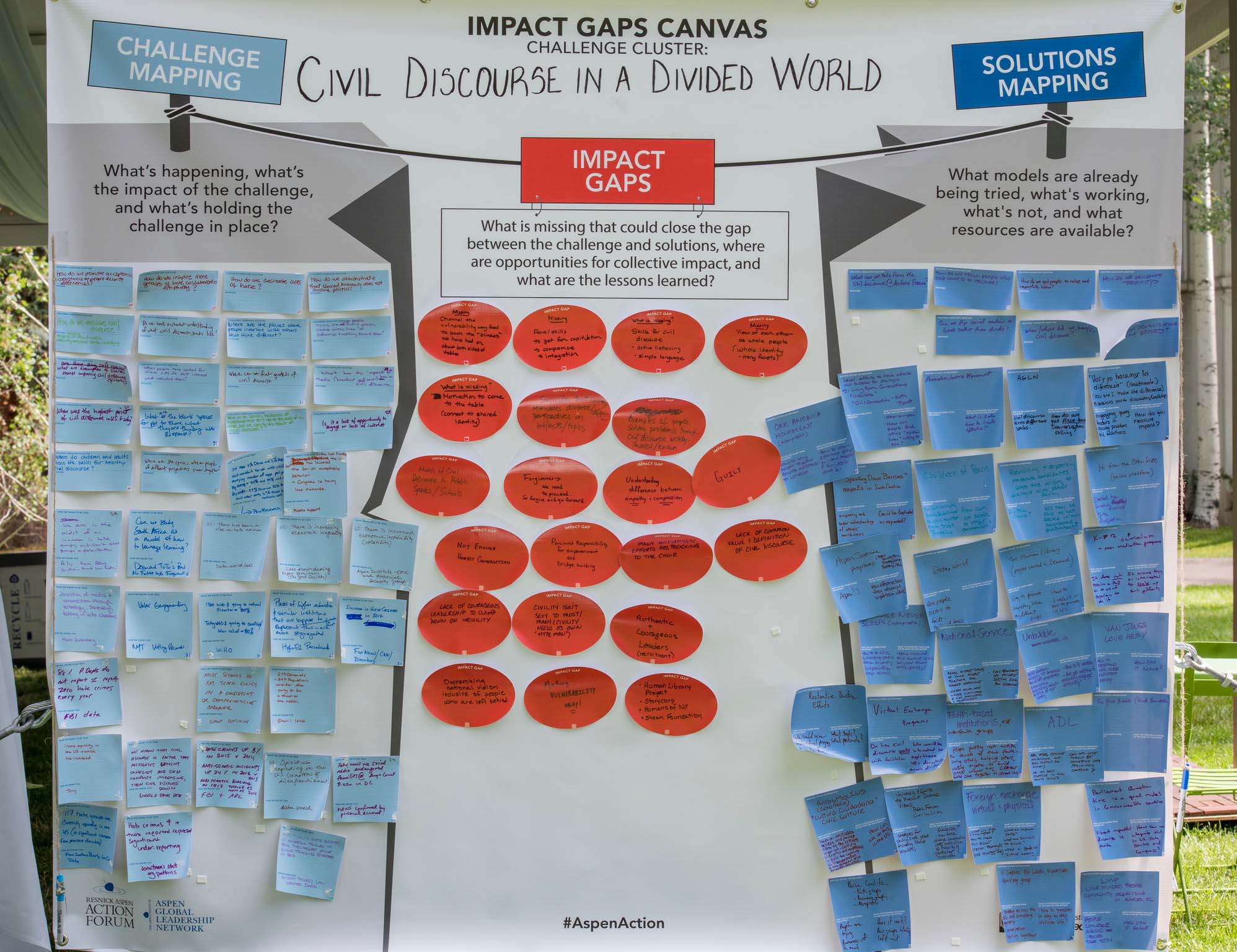
It’s important to experiment with new tools and resources to support the community you serve. The photo above is of one such tool: an Impact Map Canvas on civil discourse in a divided world.
Looking at the last two data points, we are opportunity-rich. To more intentionally design for greater collaborator and collective impact, the Action Forum team has experimented and prototyped several approaches over the years. This has ranged from new formats and experiences like the “Impact Breakouts” and “Leadership Labs” we’re experimenting with this year and various Fellowship-hosted virtual gatherings in 2020.
We have also tested the development of new tools and resources such as the “Impact Map Canvas‘ and tried to introduce new language and learnings from speakers who can help us learn to be collaborative. While testing and experimenting in intentional ways to foster collaboration, we have also de-prioritized the ritual of entering into the Action Forum with an individual Action Pledge pre-identified. While Action Pledges are still celebrated and encouraged, we hope to first offer spaces and opportunities to meet with one another to keep an openness to how a pledge can offer support, allyship, and resources to one another in the community.
Questions for Reflection:
- The “core” work of the Action Forum are its seminars while the “Impact Breakouts” and “Leadership Labs” are part of its emerging portfolio of programming. What are your core and emerging bodies of work?
- What do you want to start doing?
- What might you stop?
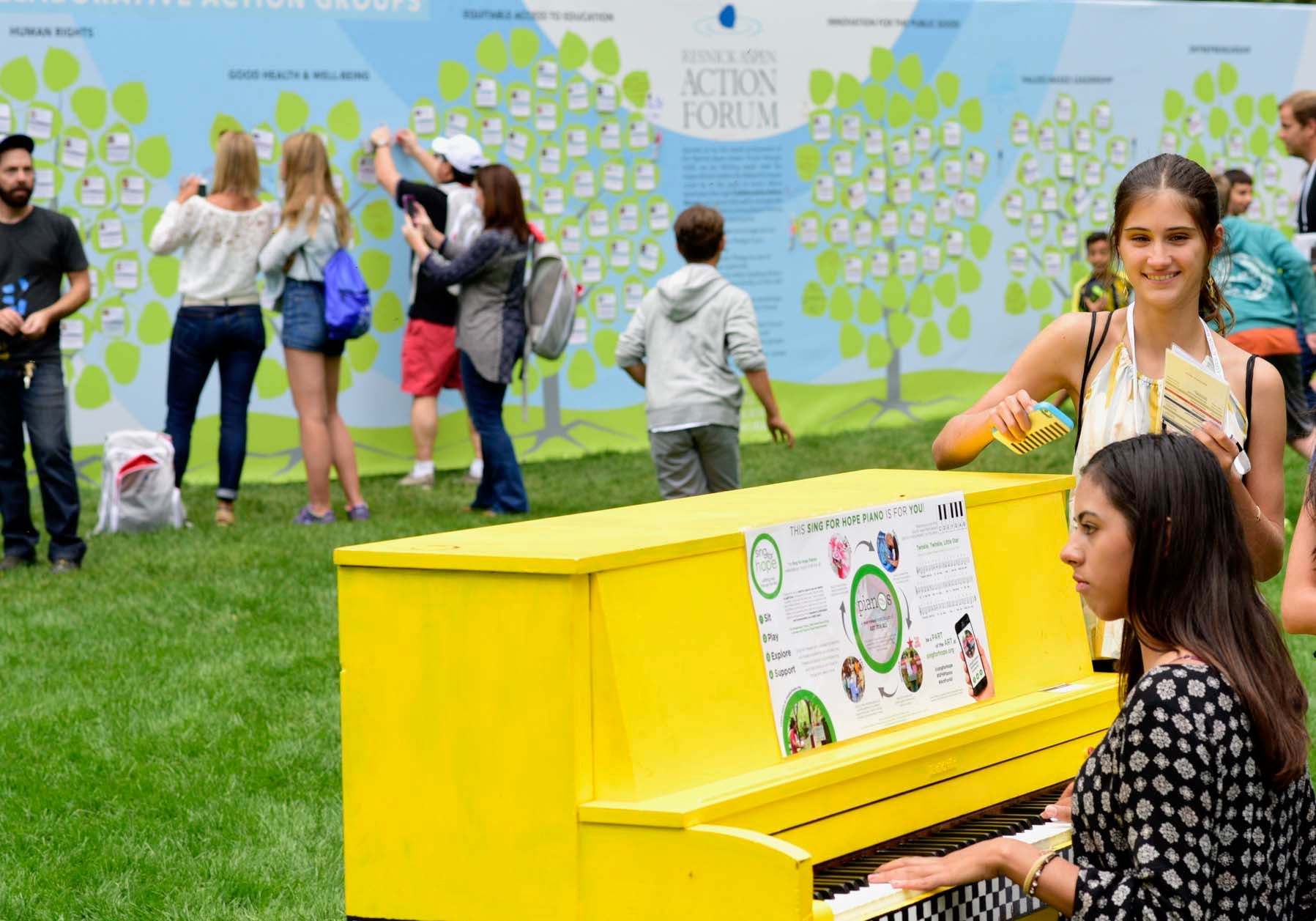
The Action Forum is a multi-generational learning space with over 100 young people ages 10 – 18 participating along with their parents. This brings a unique multi-generational and family-centered aspect to the program that has produced many learnings.
The AGLN culture embraces the Jesuit idea of “cura personalis” – care for the whole person. And in designing the Action Forum as a space to support lifelong learning, we found early on that we must consider the “whole-family” given the centrality of relationships that this set of relationships represents.
Initially, Fellows were invited to register with their husbands, wives, and partners. And then, eight years ago, we launched a youth program for 10 – 18 year olds. In the first year, we had 37 youth. Now, we’re excited to welcome 120 youth – a group that represents about 25% of our overall participants. Through this work, our team has observed:
- Leadership is a mindset accessible to anyone;
- Current societal challenges and emerging solutions will require multigenerational leadership and power sharing that needs to be learned;
- And programming – particularly seminar curriculum – can be developed for multi-generational audiences ranging from 10 – 90 years old. A shared vocabulary and experience is a powerful way to build connections within families.
And, the Action Forum is not unique in multi-gen program design. We recognize that programs such as Ascend have defined and developed the field of 2Gen impact models.
Questions for Reflection:
- What does care for the whole person look like within the spaces and experiences you offer?
- Would a multi-generational approach enhance your outcomes? If you’re considering this approach, how might you integrate and weave multi-generational perspectives and participant experiences throughout your gathering?
When developing a cohort for seminars, we reflect on what a mosaic of people might look like around any given topic. People participate from different backgrounds and cultures, privileges and abilities, lived-experiences and formal education. And the process of becoming more self-aware and self-correcting with others, can often cause uncomfortable, brave, and transformative moments.
The program foundation of the Action Forum are our seminars. At peak moments of the day, we have 480 participants between the ages of 10 and 90 in 18 concurrent cohorts of 26 people. Here, two ingredients are critical:
- The Aspen-trained moderator to hold space, facilitate dialogue, and guide group learnings.
- The physical layout of the room: simply one, large, roundtable. When sitting at a roundtable, people show up as equals. People have the best ability to listen and share with others. Participants are able to make eye contact with one another – to see each other as equals and as humans.
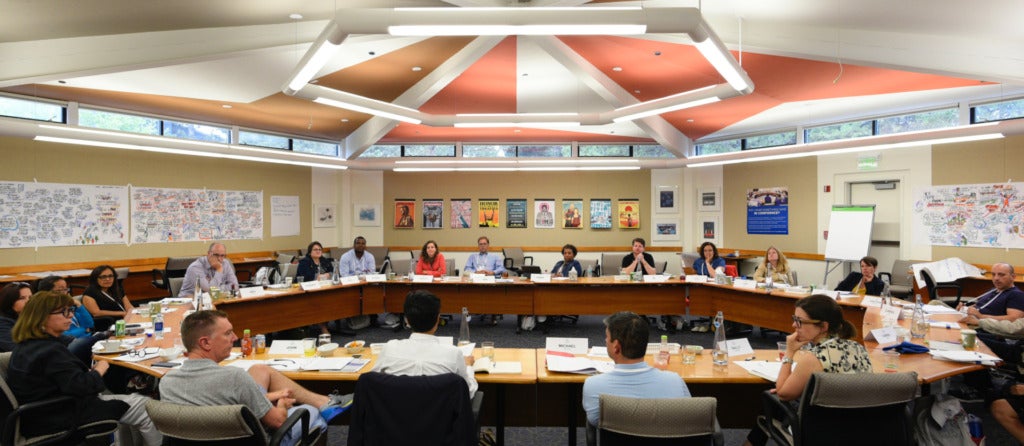
The Action Forum’s foundational sessions are text-based seminars. This photo shows the hollow circle room layout critical to making the session successful.
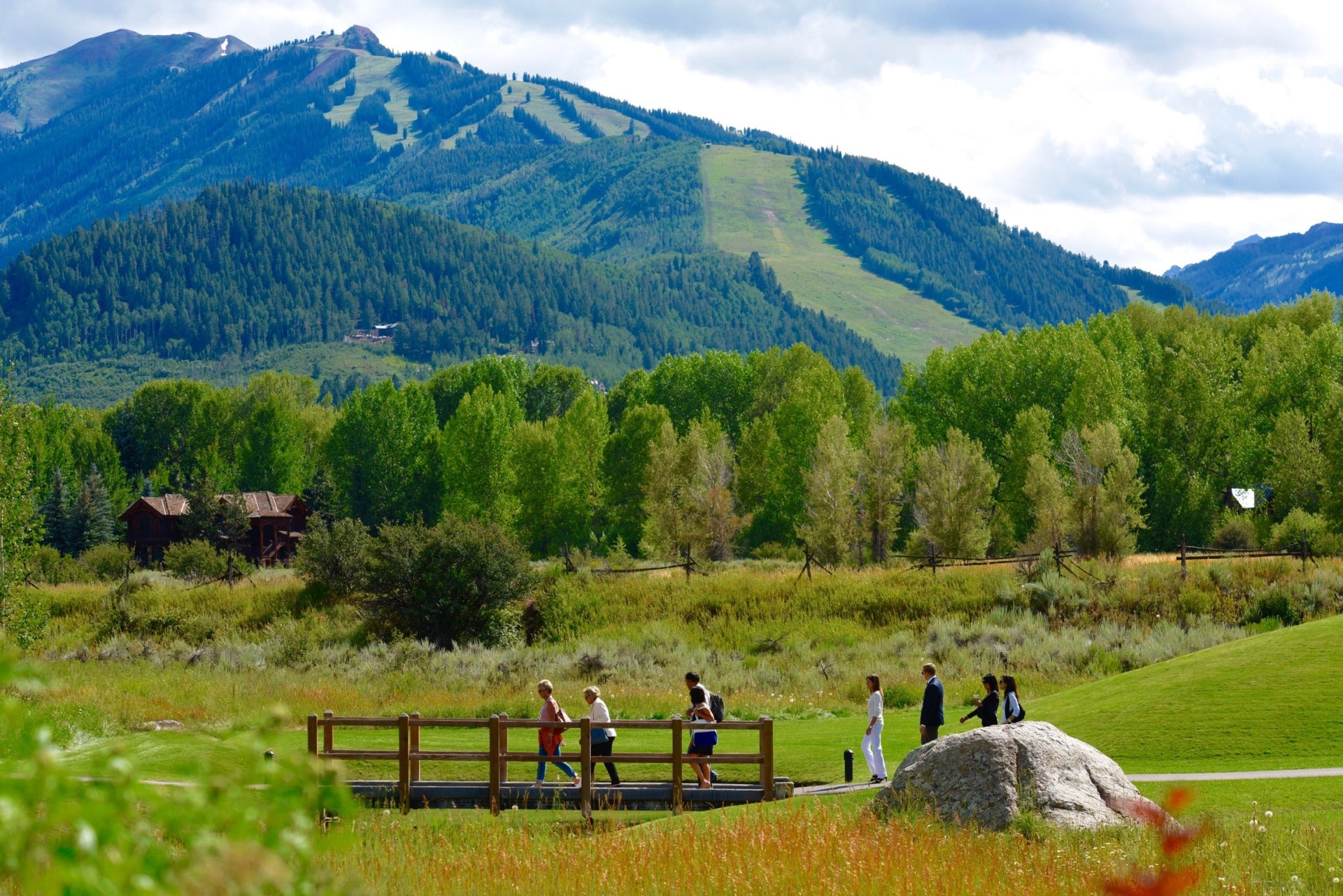
Photos throughout this post are courtesy of Dan Bayer.
Questions for Reflection:
- What peer learning techniques do you use and how do you think about bringing people together across differences? How do you support them?
- How might the Aspen Institute offer curricular or facilitation resources to support your capacity to facilitate and host roundtable dialogues?
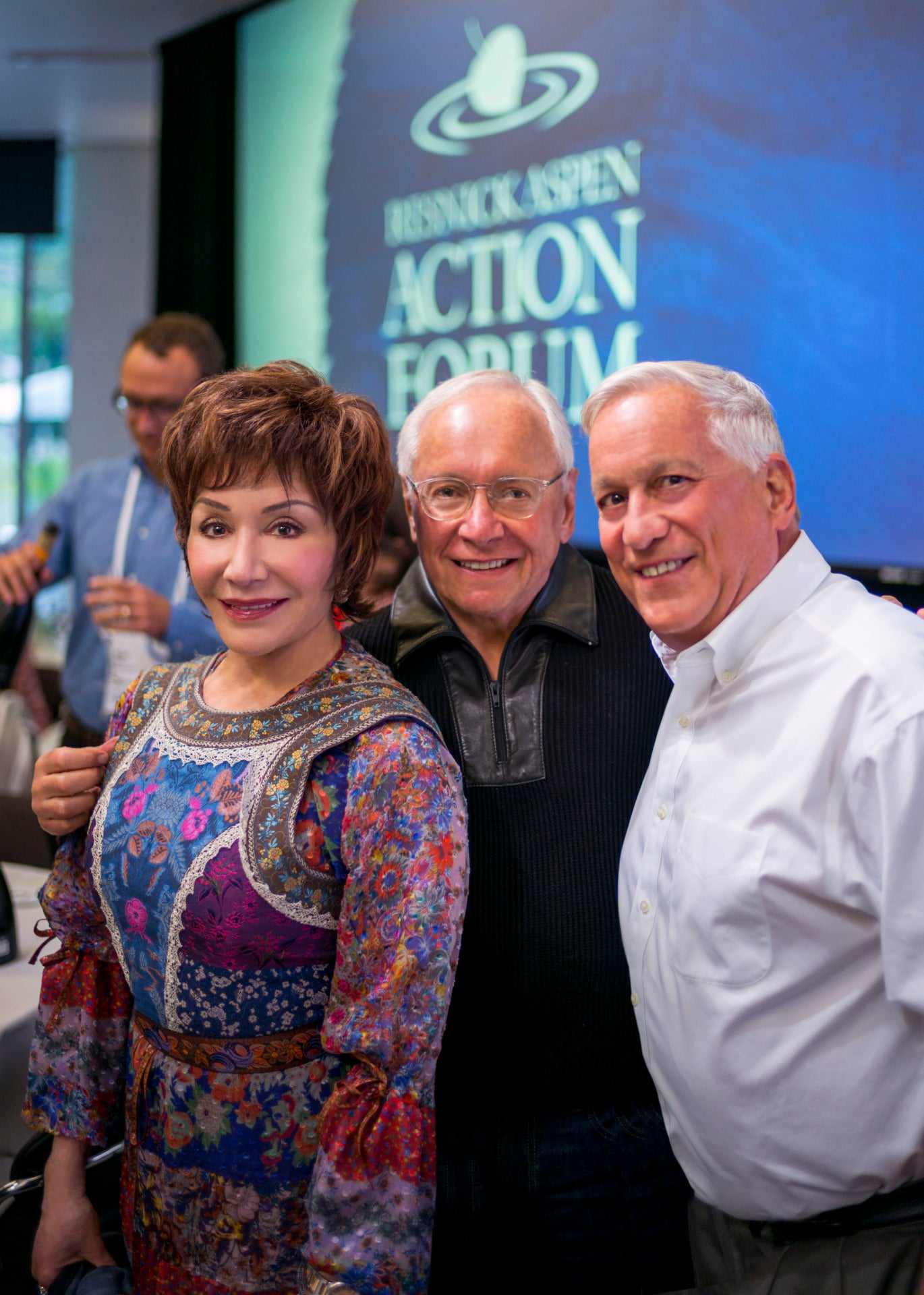
Lynda and Stewart Resnick celebrate their historic gift to move leaders into action with then Aspen Institute President and CEO Walter Isaacson.
Partnering is the best way to sustain work and build connective tissue. For this program, the story begins with the generosity of Lynda and Stewart Resnick to bring this community together for personal growth and action. Thanks to principal underwriting of this gathering through 2031, the Resnick’s gift is transformative in many ways, including the building of long-lasting and deep relationships between people from around the world.
In addition, the Action Forum has been fortunate to form multi-year partnerships with Circl.es, Mastercard, the McNulty Foundation, the Skoll Foundation, and others on topics ranging from developing workplaces that offer a sense of community and belonging, to work that advances inclusive economies, to the development of case studies and narratives that model vulnerability and inflection points in leadership.
Where we started in many of these partnerships ten years ago is not where we are today. I have found that good partnerships are like good marriages – they share a passion, commit to good communication and listening, and offer each other support to grow and evolve.
Questions for Reflection:
- What does a good partnership look like to you?
- What are ways people are able to sustain collaboration and work with others after the in-person gathering?
The nine reflections above center on people and work that supports them being in relationship. Relationships are core to sustaining long-term meaningful change. Stanford Social Innovation Review published the following: “Everything we know about systems tells us relationships are the core. Most collective impact leaders ascribe to the mantra: If you want to change the system, get the system in the room. As the late systems theorist Brenda Zimmerman said, ‘The most important unit of analysis in a system is not the part (e.g. individual, organization, or institution), it’s the relationship between the parts.’
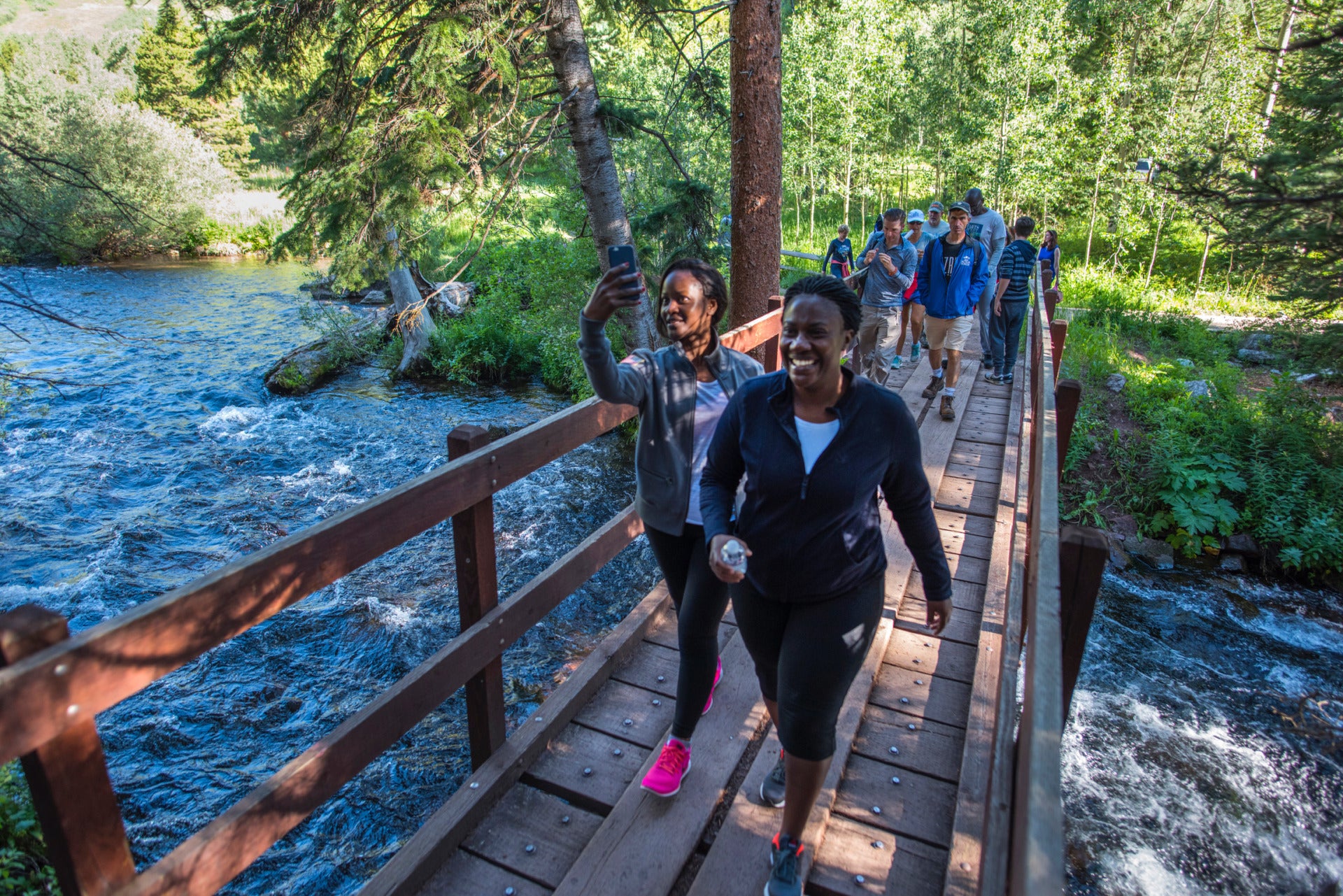
Relationships need time and space, so it’s important to prioritize room for serendipitous encounters and unprogrammed time.
The Action Forum prioritizes relationship and trust building throughout the program. For example:
While the Action Forum hosts about 480 adult and youth participants, each participant joins a small seminar cohort of about 26 people of diverse backgrounds and perspectives who stay together for the entire program. With daily two-hour seminar sessions, four total, these groups go deep. People drop their masks. They get uncomfortable and brave with how they show up with one another. And through this intentional discomfort, exchange of perspectives and dialogue with Aspen moderators holding space and guiding the dialogue, cohorts develop deeper trust within one another.
Relationships need time and space, so it’s important to prioritize room for serendipitous encounters and unprogrammed time in the schedule and in the physical space of the gathering. The 2022 Action Forum offers anywhere from 5 – 9 hours of open and unprogrammed space each day. We do this by keeping all meals – breakfast, lunches and dinners – open and without any programming and by creating spaces in the evenings for affinity groups to connect. We also intentionally include physical activities such as a popular hike in Maroon Bells and a 5K run/walk.
Being in relationships and having these exchanges impact people differently. People who are more extroverted might find these spaces to be recharging, while those who are more introverted might need time and space to be alone or in small groups to regain energy. At Action Forum, we design for both experiences by creating extra opportunities for connection – like speed networking and additional night caps – for the former, and also developing and norming spaces that are quiet, technology free, and meant for individual reflection for the latter.
Questions for Reflection:
- How do the spaces you create prioritize deep relational work?
- How does trust-building show up?
- How are open and serendipitous spaces experienced and offered to participants?
“Social change happens at the speed of relationships. And relationships move at the speed of trust.” — Jen Bailey, Field Builder Reverend, The Hopeful Buds of Pluralism in the Garden of Democracy
People who convene and hold space for others play an important role in fostering humanistic leadership. The learnings described above, from modeling how to be more vulnerable, self-aware, and self-correcting, to getting more proximate and centering equity in a way that brings people together to build relationships, co-develop approaches, and connect the assets around us, have been key for the Action Forum’s ability to create experiences that supports the whole person
These types of convenings can be multiplied – and need to be in order to foster the more humanistic leadership our world is craving. As I go forward in this work, I’m committed to investing in the well-being of people and thinking critically about how relationships can be nurtured in the spaces you hold with and for others. I hope you’ll join me.
Tommy Loper is the Vice President of Leadership Programs at the Aspen Institute.
Background
The Resnick Aspen Action Forum is meant to support people to take action – to step up for and with their communities on some of the most pressing issues we face. It was created in 2013 as the Aspen Institute’s flagship community event for Fellows in the Aspen Global Leadership Network (AGLN), their families, Fellowship programs, and other values-based, action-oriented leaders to come together to:
- reconnect and build relationships with individuals across the AGLN and Aspen Institute community as well as with AGLN Fellowship programs and other Institute programs, staff, and partners;
- pause, reflect, refresh, and focus on sustaining values-based approaches and solutions to leadership challenges;
- take action that drives impact for a more free, just and equitable world for all by joining existing or starting new efforts to address the most critical challenges of today.
The AGLN is made up of some really incredible people from 60+ countries – all on journeys to practice leading with values so that they may have a more positive impact in their lifetime. In the spring of 2020, an AGLN Impact Report was published in which the Action Forum both participated and is referenced in. The AGLN is a special community and one that’s dear to me. I also recognize that there are many other networks that are also special and impactful with people like me who are space creators and space holders. I share these reflections openly with the hope that we can come together – as organizers and networks – to be in relationship and work together.

Photos throughout this post are courtesy of Dan Bayer.

